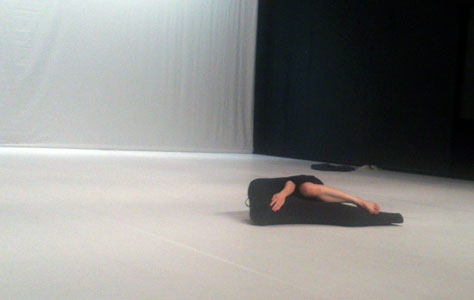
Isabelle Schad’s ‘Collective Jumps’ is an ambitious dance piece offering refreshingly unexpected views. But after its premiere last November I was hesitant to write about it as I could not come to terms with some ambiguous impressions gained. Parts of it did not make an easy fit into the progressive frame of the work’s presentation and thus I had left the piece with certain unease.
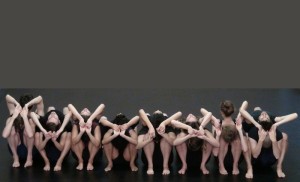
These going-a-rounds neither expressed a radical energy as in ‘Political Mother’, the Hofesh Shechter piece, which referred to folk dance as ‘Where there is pressure, there is folk dance’, nor the raw and mystic energy that is called up in Nijinsky’s ‘Le Sacre du Printemps’. A socialist or even slightly fascist imaginary of community dancing projecting the ideal of one fitting into the gap of the other was what these rhythms brought to my mind. No moment of failure or glitch to unsettle the aesthetics of the image, no dark colored leg or arm – all skin within the bright spectrum. The ‘collective jumps’ as well must have been minimal as there was not the slightest visible break in the ongoing iteration. Obviously I had missed some points of the concept. This feeling continued when I saw that the color booklet referred to texts as the one ‘On revolution’ by Hanna Arendt and drawing from it thoughts of ‘a unified, monstrous body’ as ‘possible site of resistance’.
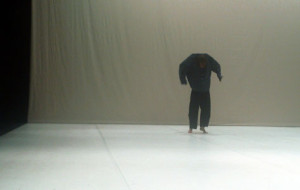
Throughout the short parts of text Isabelle Schad addressed the problematic and questions her collaborator and she have decided to work along. As Schad put it, her interest is the enquiry into a visible transformation of somatic body workings and expressions as experienced in BMC (Body Mind Centering) or Asian Body Technics, that connects with L.Goldring’s focus on representation in general and the body in particular. Goldring attributed the notion of the amplifier as an enlarging device to the concept that in their collaboration becomes redefined as “devices meant to make visible the very peculiar physicality of non-representational movements through stage settings, such as a large costume, a fabric landscape or a group of performers.â€(1) 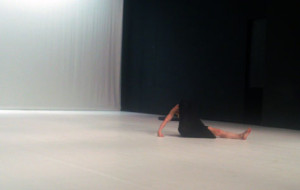
Next point on the program: ‘Unturtled #1 + #4‘. It started quite familiar after the introduction given by ‘an unfolding process’. The entering figure dressed in oversized black pants and a wide dark blue shirt appears small but accentuated in the overall white stage setting. Calm music layered the space to merge slowly into a pushing and pumping rhythm throughout the piece. But was it a human figure? The wide shirt is moving around the upper body, from one side to the other, the empty sleeves hanging loosely down. Proportions like an ancient idol. The arms of the performer obviously absent or are they eventually creating the motion of the framing shirt while forming this shielding circle above the head? The development of forms had a momentum of its own that made such guessing of technical questions irrelevant. The shapes, fascinating in themselves, are not immediately recognizable. Placing themselves between the absurd and the unknown, categories become obsolete. 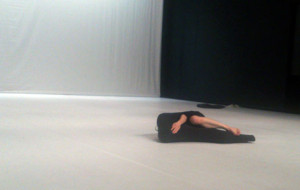
Further abstraction occurred, turning the alterations into amorphous forms, when the performer throws the shirt and curls her entire body up within the oversized pants made from elastic cloth. Sometimes a leg or hand still is sticking out of these non-identifiable organic forms as if belonging to an unfamiliar creature or – and that is the dystopic, but more actual version – a posthuman body modification of unidentifiable organs with limbs. Bewildering views – no longer reminding a human body or recognizable modifications of it. Our inner workings (cells, bacteria, …) indeed might look similar to these unusual forms. Schad’s play with the seemingly known, but unseen, in ever changing shapes demands the mind to rethink settled definitions.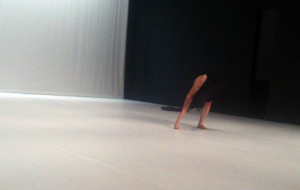
‘Unturtled #4‘ starts at the first moment similar to #1, though there is no sound. Instead the French speaking voice of Laurent Goldring, consecutively followed by a translator, informs us that due to the known inability of audiences to stand silence for a longer period, a lecture will guide us throughout the dance performance. The argument for word over music is that the later disturbs the rhythm of the performance – ignoring that speech equally has a rhythm of its own, even when consecutively translated. 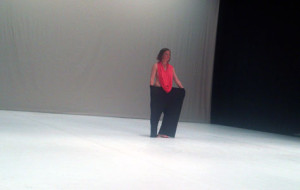
Still visible at one side of the stage the two speakers sit in the dark, beside the area marked for the dance performance. The voice-over meanders from the changing habits of western theater audiences throughout the last centuries on to the inside-outside problematic of gated communities and shopping malls. W. Disney provides the step from there to the impact of Hollywood imaginary on modern warfare and drones. The connecting element between stage and voice-over lays in the problematic of the addressed inside out relation. Schad, the dancer, performs rather undisturbed in a subtle and tenderly humorous way. The underestimated audience, trained by today’s digital lifestyle to split focus, still shares enough part of their attention to the morphing figure on stage to laugh at the right instants.
In the end then a startling moment when the two speakers leave the space obviously with microphones still on, their steps and voices audible inside the theater. The last passage had addressed warfare drones and their controlled maneuvering from a safe inside to incite remote outside destruction and/or killing. The voice-over seemed to come to a clue by continuing to speak on leaving, while I was guessing that they might want to use their ‘controll’ over the exposed performer (the stage as an exposed outside) and reveal the audience, as likewise unaffected onlookers. Soon it became clear that this twist was not intended. While bringing text to a dance performance can be an exciting experiment, in ‘Unturtled #4‘ no real connection or interaction between the two parts, the visual and the audible, was set, and this made it rather difficult to perceive both together. 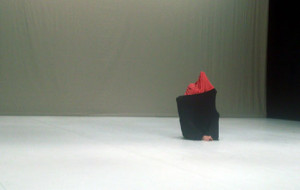
The work of Isabelle Schad and Laurent Goldring builds on rich processes, which can endure a ‘silent’ period of basic noises emerging from the movements on stage and in the audience. A successful experience for this was the intimate setting of ‘An Unfolding Process’. Another point would be that bodily processes, the material of Schad’s works, demand some time to adjust to different settings, as well as a certain excess of repetition or endurance – in real life and eventually also on stage. As in the example of a stereophonic image it needs to be stared at for some time to allow the shift of perception to happen. Also the takeover of elements from artistic performance work as today often seen in dance pieces, needs to be adjusted or rethought in the ways how to deal with different settings like open stage or endurance, etc. The excess of boredom through length and repetition visual performance artists often introduced seemed to have had reason, though solutions in dance today certainly will look different.
A first encounter with Schad’s work, especially the solo pieces as ‘Unturtled #1 + #4‘, unavoidably recall the images of Xavier LeRoy’s iconic ‘Self Unfinished’. Nevertheless she has developed her own approach to the theme, culminating in the recent group work of ‘Collective Jumps’. Schad and Goldring have come up with unique and strong solutions in the challenging transformation of somatic body features into a viewable evening piece.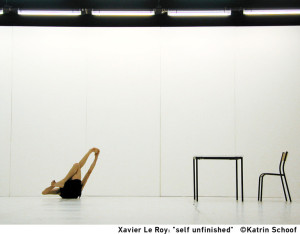
image link
But since the first staging of LeRoy’s work times and with it perception have quite changed. In today’s era of the Digital, the Anthropocene and Posthumanism the images – or as I prefer – the affecting modulations Schad creates, enter a very different field of meaning. Bodily alterations, even when in momentary flux, let us now think of human made or human influenced technologies. The work of Schad/Goldring defines the body’s inside as outside as a instable entity, and recalls that its forms are malleable. The forms affect us as modifications of the unthinkable. “The human body [..] was never an immutable object. […] The liveness of the human body depends on relational interactions with others, living and nonliving.â€(2) 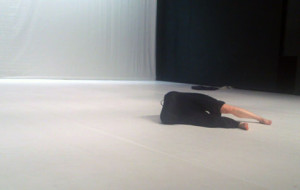
The mutated forms in Schad’s and Goldring’s pieces should not be understood as literal organic misfits or new in/organic inventions, but as possible amplifications of non-representative ‘image organs’(3) . Metaphors for yet unfinished developments that nevertheless have already started to emerge, and their turning visible on this stage is only one indicator out of others for the becoming of these ‘pre-verbal’ expressions. Embryonic thought structures of future technologies of the non/human body. They may represent a feeling for this form, or occur as a reminding future affect. Felt shapings of the body and thus also of the mind, when surrounded and ‘massaged’ constantly by technologies in daily life. McLuhan the author of ‘The Medium is the Massage’(4) stated in 1967: “The extension of any one sense alters the way we think and act—the way we perceive the world. The way we perceive our own bodies. When these ratios change, men change.â€(5) Interestingly it was McLuhan’s view that all technologies are media of extensions of (wo)men: print, the wheel, and also clothing. Donna Haraway went a step further in 1997 and addressed these interactions as infolds between organic and technological flesh(6).
Under these aspects Isabelle Schad’s play with the extreme flexibility of the stretching material of her pants becomes a brainstorming session of eventual non/human versions to come. Not mutations in the sense of literal representation, but played-through series of future extensions. These do not necessarily refer to modifications of bodies with devices permanently attached in a cyborgian way, but to becoming forms of clinging to the extensively ubiquitous technology. Schad’s and Goldring’s forms offer outlooks beyond pre-established conceptions, but also invite to feel the effected affect. Reminding: “The eye—it cannot choose but see; we cannot bid the ear be still; our bodies feel, where’er they be, against or with our will.â€(7)
As such the definition of revolutionary movements to be created by a unique collective body as one organism without the slightest (human/technological) glitch ‘Collective Jumps’ delivered a backward looking view which did not seem to be up to date with actual developments. Revolutions as we have seen them in the last years are heavily technology depended. ‘Collective Jumps‘ claims to be an expression of political thought or event, but at times it seems to be an ‘utopian’ experiment, which did hesitate to really dig into today’s complex, multifaceted and multicolored reality.
footnotes:
1) Cited fom the program leaflet and website – describes the main idea behind the series of works Isabelle Schad and Laurent Goldring
2) Marco Donnarumma
3) See HAU leaflet supplement: Goldring’s basic idea is that images are not representations but organs – like other organs as well.
4) McLuhan frequently punned on the word “message” changing it to “mass age”, “mess age”, and “massage”; a later book, The Medium is the Massage was originally to be titled The Medium is the Message, but McLuhan preferred the new title which is said to have been a printing error.; http://en.wikipedia.org/wiki/The_medium_is_the_message
5) McLuhan, Marshall, ‚The Medium is the Massage’, Bantam Books, 1967; see also here: http://www.themediumisthemassage.com/
6) D. Haraway, When Species Meet, 2008, p.11-12
7) William Woodworth reprinted in M. McLuhan ‘The massage is the message’, 1967, Bantham Books

thank you for this very interesting article.
Just a precision, about the reference you make to Self unfinished,the real connection is that Le Roy’s piece also has been made “after a collaboration with Laurent Goldring” as stated in the credits.
My Best
Laurent Goldring
Thank you for that interesting information!